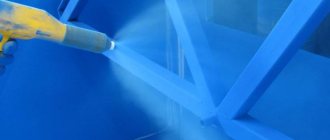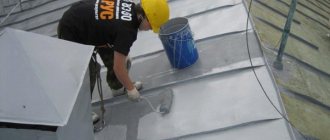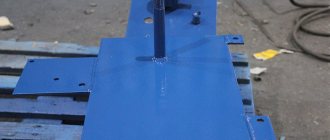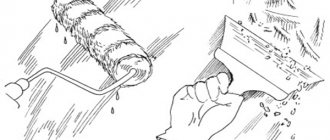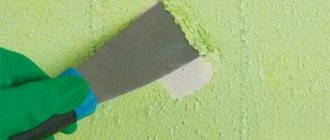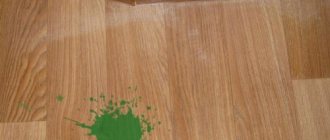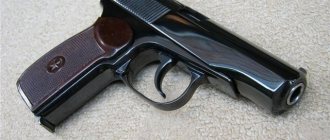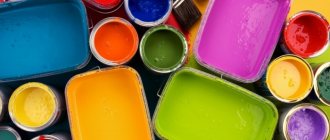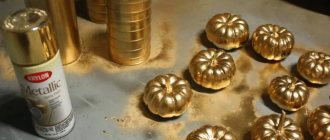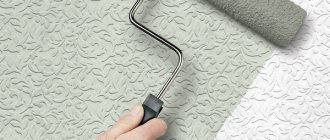Sometimes paint stains appear on the surface of a product by accident. To cope with the task, you need to act carefully, following the advice of professionals.
In this article you will learn how to remove old paint from metal at home.
Preparatory stage
Before you start work, you need to prepare properly . This complex includes:
Purchase of tools and household chemicals. Depending on the chosen cleaning method, you will need: a grinding machine, a hair dryer, paint remover, a spatula, kerosene, a brush, etc.- Protect surrounding objects from dust and other contaminants. For this, polyethylene film is used.
- Prepare personal protective equipment. The classic set includes: gloves, construction glasses, respirator.
- Prepare the metal surface for upcoming cleaning. Dust and other contaminants are removed from it. If household chemicals are used, you can clean the paint with a stiff-bristled brush. This will increase solvent diffusion and speed up the reaction.
When all the preparatory steps are completed, you can begin to work.
How to remove from the gate?
To remove paint from metal gates, you need to perform the following procedure:
Garage door painting process
Painting metal gates using a roller
Painting garage doors is the most important undertaking, the quality of which determines not only the appearance, but also the service life of the coating. To apply paint, a roller or spray gun is usually used in order to avoid pronounced stains.
For high-quality painting, you must adhere to several basic rules:
- Paint application begins from the top of the gate, gradually going down, which avoids drips and sagging;
- When applying paint in stripes, each subsequent stripe must overlap the previous one in order for the surface to be uniform.
- It is better to paint in lines from top to bottom, visually dividing the surface into several parts. It is advisable to apply paints and varnishes in two or three layers, this will help give the surface a more saturated color and avoid accidental omissions.
Important. When choosing an option for how to paint a garage door, keep in mind that using a spray gun significantly reduces paint consumption, but there is a high probability of paint getting onto adjacent surfaces that must first be covered. Also, the spray gun should not be used in strong winds.
From this material you learned how to properly paint a garage door and prepare the surface. It is advisable to carry out painting at an ambient temperature of +10 to +25 degrees and in the absence of humidity.
To consolidate the material, we recommend watching a video about the process of painting garage doors.
Features of removing different types of paint and varnish products
Any paint can be removed mechanically, thermally or chemically, but sometimes certain methods are preferable.
| Paint type | Removal method |
| Oily | A thin layer can be removed using any remover, for example, using acetone. A thick old layer requires mechanical cleaning. The most difficult areas are burned out. |
| Acrylic | The paint responds well to solvents and removers. To increase the efficiency of work, the surface should be cleaned. |
| Powder | The most effective way to remove paint is to burn it. If this method cannot be used for the product, then they resort to chemical agents, for example Fail-4 or Remover. |
| Aerosol (from a can) | You can get rid of such paint using sandpaper or a wire brush. For high-quality removal of the composition, the surface is treated with a solvent. |
Remover for water-based paint
Water-emulsion layers after polymerization are quite dense; they can withstand the action of ordinary water. However, when the temperature increases to 60...70 °C in an aqueous environment, swelling of the paint coating is noticeable.
In a dry state, it can withstand exposure at higher temperatures (up to 130 ° C); in the presence of moisture, long polymer molecules break down into smaller fragments. The moisture itself penetrates into the layer. The old paint begins to be washed off.
It is even easier to remove the old layer using wallpaper glue (Fig. 1).
Rice. 1 Wallpaper glue for removing the water-based paint layer
- It is diluted in water.
- Let it brew for about an hour.
- Apply sheets of paper, such as newspapers.
- Let the glue soak in.
- Then newspapers with glue are applied to walls painted with water-based paint.
- After half an hour, the entire surface swells.
- A scraper can easily remove newspapers and swollen water-based paint.
Excellent results are achieved by using a ready-made solution (Fig. 2). It is applied to the wall using a brush, paint brush or roller.
Rice. 2 Universal remover of old paints made in Germany “Hempel”
Attention! If this wash is stored in the cold for a long time, then separation of the solution occurs. It is restored by heating to 60 °C. Then you need to mix.
This material effectively removes not only water-based and dispersed coatings. It is used to remove oil paints.
The most common mistakes
When removing paint from a metal surface, you should avoid the following mistakes:
Using a hair dryer or torch indoors. When heated, paint will release toxins, so poisoning cannot be avoided. Such work should be carried out in the fresh air.- Firing of brass and cast iron products. When heated, these metals become covered with scale and become brittle. This will lead to their rapid destruction.
- Working without personal protective equipment. Failure to follow basic safety precautions increases the risk of injury.
- Mechanical cleaning of thin sheets of metal. Pressing too hard may damage them. The product will lose its shape, or dents will appear on it, which will be difficult to straighten.
In order to avoid mistakes when performing work, you need to know what metal the product is made of and what type of paint it is coated with.
Choosing paint and primer for garage doors
Pigments that affect rust.
Garage door paint must meet certain requirements:
- good paint coverage;
- enhanced adhesion on metal surfaces;
- should not contain components that oxidize the metal;
- high resistance to moisture and good water-repellent characteristics are required;
- the elasticity indicator must correspond to metal paints so as not to crack at high temperatures;
- thermal range of use for painting – frost resistance and heat resistance;
- resistance to aggressive chemicals - gasoline, solvents and technical oils;
- high resistance to impacts and mechanical wear.
Which garage door paint ideally matches the characteristics described above:
- silicone enamel – high strength and elasticity of the paint, with excellent resistance to moisture and a long service life. These garage door paints have excellent adhesion to metal and even coverage. All organosilicon enamels have anti-corrosion properties.
Advice. This paint can be used to paint garage doors that are constantly exposed to direct sunlight, especially in the southern regions of the country. The coating can withstand temperatures up to 600 degrees without changing color or durability.
- alkyd enamel – high elasticity and durability, suitable for interior and exterior decoration, large selection of colors. Alkyd-urethane enamel is a reliable budget-friendly paint option for any garage door;
- hammer paint – resistant to corrosion, you don’t have to clean the surface to perfection, no need to prime, excellent dirt-repellent effect. It is better to apply from a spray gun under pressure;
- Acrylic enamel is an ideal, easy-to-use solution. The best paint today, can be used for any garage door. It has all the necessary characteristics - it can withstand sudden temperature changes, is not afraid of moisture and aggressive substances, and is resistant to any atmospheric conditions and high temperatures. The color palette, although small, is rich and deep. The only negative is the high price.
Important. When choosing what kind of paint to coat your gates with, avoid oil paints; they will crack very quickly.
For metal surfaces, craftsmen advise using fire-retardant coatings “Polistil” and electrically conductive dyes. These are special paints designed for auto repair shops and other special garage operating conditions.
Brands of popular domestic and imported metal paints
We offer a rating of materials recommended by users:
- primer-enamel “SPETSNAZ XV-0278” Yaroslavl paints, on rusty surfaces;
- hammer Hammerite, dark brown color, should dry and polymerize for three weeks, then I cover the second layer;
- "Alpina Direkt auf Rost" can be applied to rust. Must be completely hardened to coat a second time. Color - white, black and silver;
- you can choose Kuzbass varnish for metal surfaces, one layer is quite enough;
- the entire line of metal materials “Smile” - beautiful appearance and resistance to high humidity;
- “Dufa” hammer, for metal, can be applied with a brush, the appearance is excellent, but it must dry for two days before painting again.
When choosing paint, a lot depends on the condition of the gate and, of course, financial capabilities. Some people simply dilute powdered silver and cover it over the most inexpensive primer, but it looks like a very expensive elite coating.
Primer
We offer several interesting, proven primer options that must be applied before painting the garage door:
- ship red lead - a reliable and inexpensive solution;
- silver – it is used when priming the car body earlier. Gives a metallic and pearlescent tint to any paint. It’s cheaper and better to choose a simple option - buy aluminum powder separately and dilute it with drying oil. Coating - in one thin layer;
- phosphating primer VL-02;
- use metal lead;
- primer for metal GF-021.
We prime only on a previously cleaned and degreased dry metal surface.
Color selection
The color of the gate depends only on the preferences of the garage owner as to what paint to use. But, it is necessary to take into account that dark colors attract heat from the sun, and light colors reflect it. The most popular colors are dark green, brick, light blue and burgundy.
Important Tips
When removing paint from metal, you should use the following recommendations:
- Observe safety precautions. Hands, respiratory organs and eyes need protection.
- Take care of cleanliness. Less dust will form if you spray the surface with water before mechanical cleaning.
- Do not overheat the paint to prevent it from catching fire. You can start applying the metal remover or solvent only after it has cooled down. Such liquids are flammable.
- In order not to damage the surrounding surfaces, they are covered with cloth.
Precautions and simple method
Some metal products are quite fragile, so they cannot be processed with a blowtorch or cleaned with tools with abrasive components. Others tolerate hard brushes, sandpaper and even a hair dryer just fine. The method for removing the protective suspension is chosen depending on the thickness and composition of the base, as well as the type of paint itself.
The most economical method is mechanical. You will need a rigid stainless steel spatula or a kitchen knife. The main thing is that the tool has a sharp blade.
The painted surface is carefully inspected and a weak spot is found where the coating is swollen or cracked. The protective layer is pryed off with the selected tool and removed, trying to capture rust, if any.
The second stage of the mechanical method is grinding. You need to arm yourself with coarse sandpaper with water-repellent properties. If you take a simple variety, it will quickly wear out and become unusable.
The workpiece is fixed on a block of hard plastic or wood to make it more convenient to grind the metal and level it. The base, which is treated with sandpaper, is moistened with cold water. Removing old paint from the facade of a wooden house?
It is advisable to use a spray bottle so that the liquid is evenly distributed over the item. Water ensures the sliding of the abrasive surface and does not allow dirt and rust particles to rise into the air.
Repair work will take a long time if you have to clean an iron gate or fence. In such situations, the spatula is replaced with a grinder or drill. You will need a nozzle with hard bristles.
It is put on a power tool and the cast iron or iron product is polished until the layer of protective suspension disappears.
The result is secured with anti-corrosion impregnations, which fill small cracks and chips left after mechanical cleaning. Items that are planned to be painted again must be treated with a primer.
The method has several significant disadvantages:
- A drill or putty knife leaves indentations on thin-walled objects.
- Stubborn paint is difficult to remove mechanically.
- During operation, dust consisting of old coating, metal particles and rust rises into the air. If a person does not use a respirator and safety glasses, substances enter the mucous membranes of the eyes and nasopharynx, causing irritation.
If you need to clean large objects with thick walls, such as pipes, it is recommended to call a specialist with sandblasting equipment. The metal surface is treated with a jet of fine abrasive, which removes both paint and rust.
How to paint sectional doors?
Manufacturers of modern household garage doors advise not to carry out experiments and in case of mechanical damage to the door panels or paint defects, completely replace the lamella rather than repainting it. This is true especially for “fresh” gates, because complete or partial repainting will only spoil their appearance. Do not forget that often replacing the canvas can be many times cheaper and easier than painting. And the result will last longer. If your gate has stood for more than 5-10 years, then the door leaf is outdated, including morally. During this time, technology has stepped forward.
Read about the new matte coating from Alutech with improved protective characteristics.
Why not add some color and make your gate pop?
If the gate has served you for a long time and has lost its appearance, you can not only repaint it manually, but also order painting from professionals. But before you look for someone who will paint the gate or rent a sandblaster, consider what will be cheaper.
Many people paint their sectional doors directly over the old or even new paint; they bought and installed it, didn’t like the color and decided to repaint it. The question of how long this “solution” will last depends on the quality of the paint and weather conditions. But the service life will obviously be reduced due to a violation of the technology, so you will not receive official permission from the manufacturer; paint at your own peril or risk.
Garage Doors | 12/29/2018 Share this article: You may also find it useful Check out our products - 27% from RUB 40,724. from RUB 29,729 Order
Alutech Trend series. Fabric type: S-corrugated straight. The color of the panels is white. The opening width is 1750 mm. The height of the opening is 1750 mm. Jumper - 250 mm. Balancing type: torsion springs. Control type: manual.
— 35% from 25,758 rub. from 16,743 rub. Order
Garage roller doors made from PD55mN profile. Opening width 2200 mm. Opening height 2200 mm. For installation in the opening. Control - PIM (spring-inertia mechanism) + deadbolt lock.
Removing old coating from brass products
Door handles, iron plates, hooks and other fittings are cleaned carefully so as not to be damaged. The old coating is first soaked and then removed mechanically.
- ceramic pan;
- detergent;
- kitchen or stationery knife;
- nylon brush;
- kitchen tongs;
- screwdriver.
Use a knife to pry up the plate and slide the blade between the fittings and the door. Unscrew the screws and remove the handle. The screw heads are cleaned with a knife or brush.
Chemical options
Metal objects with a relief surface are treated with solvents. They are:
- universal;
- substances for ferrous and non-ferrous metals;
- multifunctional, removing paint along with putty and primer;
- oil-based coating removers.
Tip: It is better to buy remover at a hardware store. Powders and emulsions for removing paint from metal are also sold in car dealerships, but there they cost two to three times more.
Solvents soften the old coating, but you will have to separate it from the base with a stiff-bristled brush or spatula. A person who has chosen the chemical method must stock up on a respirator, safety glasses and rubber gloves. You will need a special suit and shoes.
Apply the remover in a thick layer using a brush. The paint is removed in several stages:
- The metal surface is wiped with a damp cloth to remove dirt, then disinfected.
- Treat the prepared item with a solvent and cover it with plastic wrap so that the substance is better absorbed into the old coating.
- Timed for 5–20 minutes. The time depends on the type of remover and the thickness of the paint layer.
- The soft covering is torn off with a spatula and swept into a heap so as not to be trampled into the ground or floor.
- Remains of paint are removed with a stiff brush with metal bristles.
The surface must be wiped with special compounds, for example, mineral kerosene, to remove the solvent. A product to remove old paint from window frames? The substance must not be left on the metal base, otherwise the new layer of paint will not be able to adhere and will fall off.
Acetone can soften old coating. Soak a rag or gauze with the liquid and apply it to a metal surface. Cover the top with plastic film and secure the structure with tape.
Leave for 10–12 hours for the acetone to absorb and begin to work. The fabric is removed gradually, the paint is immediately cleaned off so that it does not have time to harden.
The cleaned surface is coated with an anti-corrosion primer. Some aggressive compounds destroy metal objects and cause rust.
Safety features and tools
Safety construction glasses
To work safely with various paint removal methods, you may need:
- respirator,
- protective glasses,
- latex gloves.
- Bulgarian,
- Sander,
- construction hair dryer,
- burner or blowtorch;
- special chemical agent (wash),
- acetone and more.
Technical acetone
The use of chemicals should always begin by studying the instructions that come with the product when it is sold.
Due to the toxicity of chemical materials, an important condition must be observed - a well-ventilated area where work is carried out.
Thermal method
A blowtorch, hair dryer or gas torch will help remove several layers of stubborn paint. The metal surface is washed, removing dust and dirt, and after drying it is treated with fire or a stream of hot air.
High temperatures soften the old coating. It separates from the metal surface and bubbles appear. The heated paint is immediately removed with a spatula or knife. You need to hold a blowtorch in your left hand, and peel off the coating with your right.
You can work together to finish faster.
There should be no flammable objects made of wood, paper or fabric near the surface to be treated. The paint is removed carefully so that hot particles do not get on the skin. The softened coating eats into the epithelium and leaves a burn that does not heal for a long time.
Do not burn cast iron or brass products. Some types of metal become coated with scale, become brittle, and are destroyed when treated with a blowtorch. On others, cracks appear due to uneven heating.
Do not use a gas burner or hair dryer indoors. The paint emits toxic substances, so work is carried out outdoors or in a ventilated area.
The layer of old coating can be removed quickly and efficiently using mechanical or chemical methods. Removers and brushes do not destroy metal surfaces and do not leave dents or cracks. The thermal option is rarely used and all the pros and cons of such cleansing must be weighed.
Be sure to wear protective gloves and a respirator to prevent hazardous fumes and chemical toxins from entering your respiratory system or on your skin. Before applying the remover, you need to carry out preparatory work: clean the surface of dirt and dust with plain water or a detergent. Apply the composition to the old paint for a period of time recommended by the manufacturer.
The product is applied in a thin layer of a few millimeters to the surface. Products for removing old paint from metal surfaces? Once peeling begins, begin removing the old paint layer with a putty knife.
After chemical treatment, the coating will peel off in layers and be easily removed.
A heat gun can also help if the surface can be heated strongly, which is not possible when processing many communication pipes. You need to bring it to the surface, the old paint will begin to peel off as it heats up, and all that remains is to remove it with a spatula. When working with these tools, you need to be very careful not to burn your hands on the hot metal . After this method, scale forms on the surface of the metal, which must be cleaned off.
Burning out the coating in such ways is definitely not suitable for sheet iron, since it is deformed by local heating, and for cast iron products, which can crack.
The range of metal brushes, as well as sandpaper, pleases with its diversity. And their price is low. They differ in hardness and are good at removing old paint along with rust.
After treating the problem area with a brush, it is advisable to go over it with sandpaper to remove any remaining roughness.
This method is most popular when it comes to a relatively flat surface. You can remove old paint from metal manually using sandpaper or a wire brush, or using a power tool, for example, using a special attachment on a drill.
There are also disadvantages: such equipment is very expensive and the cleaning process itself is difficult to control. That is, there is a danger of damaging the top layer of metal when removing old paint. Thus, sandblasting work in specially equipped rooms by the hands of experienced specialists.
How can I remove it?
There are three main ways to wash paint off your hands:
- Products with an abrasive effect, such as washing powder.
- Natural solvents (for example, citric acid).
- Chemical solvents (gasoline, acetone, etc.)
Removing the coloring agent by any of the methods, to a greater or lesser extent, negatively affects the skin of the hands, which then needs to be moisturized and nourished with the help of creams.
Gasoline and kerosene
Gasoline (preferably purified) and kerosene can act as effective solvents. They should be used carefully, avoiding smearing the substance on the skin of your hands that is not stained with paint.
Application:
Soak a rag in kerosene or gasoline.- Rub the stained areas on your hands for a minute.
- Rinse with water.
- Wash your hands with soap.
- Pat skin dry.
- Apply hand cream.
The advantage of the cleaning method is efficiency.
There are also disadvantages:
- toxicity of the substance itself and its fumes;
- irritating effect on the skin;
- not recommended for use in children.
Acetone
This substance belongs to the universal cleaners. It is used to remove contaminants.
Apply it directly to the areas of contamination and rub for a few seconds, then wash your hands with soap.
Acetone has an unpleasant, pungent odor, but it is good at removing polyurethane dyes and silicone sealant residues from hands and other surfaces. The advantages and disadvantages of acetone are the same as the previous method.
Oil products
In cases where the skin is stained with acrylic, enamel and nitro-enamel, oily, fatty substances can be used for cleaning.
For use you can choose:
- vegetable oils;
- melted butter;
- melted margarine;
- animal fat.
Advantages of this method:
- Environmentally friendly.
- Harmlessness.
- When rubbing a greasy product, you don’t have to be afraid that it will get on unstained skin - it won’t cause any harm.
- Can be used even by children.
There is only one drawback - poor efficiency . In order for the fat applied to the skin to remove the paint, you need to rub it in for 5 to 10 minutes.
The oil may not be effective against some stains, or when the skin on your hands is significantly dirty.
How to remove with washing powder?
The abrasive property of the powder is used to clean hands. The effect is achieved by purely mechanical action on the stains.
Procedure:
- Apply a small amount of powder to the area where your hands are dirty;
- rub;
- wash off.
The disadvantage of this method is its negative impact on the skin of the hands. The sharp edges of the grains during active friction not only destroy the paint layer, but also injure the skin.
Intensive cleaning may damage the skin - the formation of abrasions and wounds that will have to be further processed and treated.
Instead of washing powder, the following substances can be used: salt, soda and even sugar.
Toothpaste
The active substances in toothpaste can also serve as a means of removing paint from hands.
Mode of application:
- Wet your hands with water.
- Squeeze a small amount of toothpaste onto the stained hand.
- Use the fingers of your other hand to rub the paste into the stain.
It is not advisable to use pastes with a strong menthol effect for removal, as they can cause irritation.
Lemon acid
The use of natural acids is one way to remove paint from skin. Despite its natural origin and use, even in cooking, citric acid is quite caustic if applied directly to the skin.
For treatment, it is convenient to use a napkin or sponge (if the stain is very small) . After removing the dye using acid, you must wash your hands. You can also use acetic acid.
Alcohol
Preparations containing alcohol can serve as solvents if no other means are at hand.
Suitable for cleansing:
- vodka;
- medical alcohol;
- alcohol-based antiseptics, etc.
Application:
- Apply an alcohol-containing substance to the paint using a napkin.
- Process for about 10 minutes.
- If the alcohol has evaporated and the napkin has dried, it is moistened again.
- Wipe your hands with a rag.
- Wash your hands with soap.
- Apply hand cream.
Removing old paint from metal
When you need to renew a metal coating that has many layers of paint, you should be prepared for a labor-intensive process. By the way, removing paint can be difficult, because manufacturers try to make their product wear-resistant and durable. Old paint can be removed in the following ways:
As practice shows, it is most convenient to remove paint from metal with a special liquid. To understand why this is so, it is necessary to study each of the above paint removal methods.
If you have hand or power tools in your home, you can use them to remove old paint from metal. By the way, consumers often choose hand tools because they are less expensive and easy to use. Although, when it comes to the need to remove paint from metal, wire brushes are not the best option. It is more rational to use a grinder for this, which uses a wire brush as an attachment. A drill with a metal brush installed in a chuck can also be used. However, this is a rather inconvenient method.
To remove the old paint surface, you can also try the thermal method. In this case, the coating heats up to such a temperature that the paint begins to peel off. Then it is removed from the metal using a spatula. Metal products do not lend themselves well to thermal processing. Such a surface quickly releases the heat it receives, so the paint does not have time to melt. The solution is to use a blowtorch to heat the metal surface, although this option is not suitable for some types of metals.
What type of paint to choose for garage doors
What paint is suitable for painting garage doors?
The modern market of paints and varnishes can offer a huge number of different mixtures, among which it is very easy for an unprepared person to get confused, even knowing the above requirements. So, our garage door paint should be heat resistant, water resistant and intended for painting metal surfaces for outdoor use.
The paint layer must withstand the ingress of chemicals, have an elastic structure and withstand mechanical stress. Let us immediately note that the price of such paint will be significantly higher than that of a similar product for interior work.
Three types of modern paints fall under the physical properties we have defined:
- Acrylic paint is the most modern type of coating, which fully complies with the characteristics listed above. This enamel belongs to a high price category, but such costs are justified by its long service life, provided that the application technology is followed.
- Silicon-organic paint is characterized by increased strength and high elasticity of the applied protective layer. It has excellent adhesion to many materials and, due to the presence of silicon in the composition, gives the metal additional anti-corrosion properties.
- Alkyd paint can be used for interior and exterior painting; it has good elasticity and resistance to mechanical stress. The composition has a huge selection of different color variations, but many brands of this paint do not tolerate exposure to ultraviolet radiation, which leads to loss of color characteristics of the coating.
For your information. If your gate is actively exposed to the sun, then it is recommended to choose silicone compounds, as they can withstand high temperatures without losing their physical properties. Acrylic-based enamels have virtually no odor, do not emit toxic substances and can be used for interior painting. Take these features into account when choosing what paint to paint your garage door.
Metal removal
Special paint remover is easy to purchase. Such products are produced by many companies and firms. In particular, the following washes can be found on the market:
Each liquid for cleaning metal from paint/varnish has its own specifics, so before use it is important to read the manufacturer’s instructions. Paint remover can be of different consistencies:
- Gel and liquid
- Dry powder
- Aerosol.
Although the hardest thing is to decide not on the type of wash, but on its manufacturer. According to consumer reviews, domestic products and foreign products, “BODY”, perform best.
Washing technology
The process of using a special paint remover is extremely simple. To remove paintwork from a metal product, you need to apply the substance and leave it for a certain time (about 15-30 minutes). The expiration date of the washing substance is indicated on the packaging. By the way, there are also compounds that begin to soften the coating after 36 hours. Previously, it makes no sense to treat the surface with a spatula, since the remover will not yet take effect.
Some people find that the gel is more convenient to use because it can be spread evenly. After the chemical reaction is complete, the enamel swells and begins to peel off. It is necessary to carefully go through the sander, sandpaper, spatula and remove the paint. In any case, you should work carefully so as not to spoil the base. When the metal structure is cleaned, it must be coated with an anti-corrosion substance. Now you can start choosing new paint to refresh the metal surface.
The process of removing paint from metal is quite long and painstaking: you need to get rid of the old paint and varnish coating and at the same time maintain the integrity of the product. This requires time and practical skills. If there are none, it is better to contact professional specialists. You can find experienced craftsmen who can help remove old paint from metal and other surfaces on the Yudu recruitment service.
DIY hair dryer repair
All electrical tools tend to break. If there are minor problems, you can repair the hair dryer yourself. The main working parts of a hair dryer are a heating coil, a fan, and an electric motor.
- Try to find the cause of the problem. Perhaps the power cord is broken, or the wires are burnt, or the coil is burnt out.
- Arm yourself with a screwdriver, soldering iron, find the hair dryer diagram, which is in the instructions for working with the hair dryer.
- Prepare the surface on which you will disassemble the tool.
- Remember in what order you disassemble the hair dryer. It is very good to use a camera to photograph all stages of disassembly. This will help you not to rack your brains over where to place the extra parts left after assembly.
- Start by checking the plug, power cord, and contacts. Replacing the cord, buttons or soldering wires is not difficult if you have certain skills.
- If the motor or fan breaks down, it is better to take the hair dryer to a workshop.
